Ditapis dengan
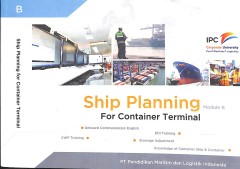
Ship planning for container terminal modul B
Buku ini merupakan buku modul ship plainning for container terminal. Yang mana buku ini membahas mengenai "container". Buku ini memuat pula EDI Training for TO II Ship training
- Edisi
- -
- ISBN/ISSN
- -
- Deskripsi Fisik
- 117 p.,; illus : 15 cm
- Judul Seri
- -
- No. Panggil
- IPC GUI IND s

Preparation of dry ports for a competitive environment in the container seapo…
The significant exodus of containers inland due to the container revolution has increased the salience of inland terminals for efficient freight distribution. Further, the migration of containers gradually inland has forced seaports to depend on these inland terminals to determine their competitiveness and offer a mechanism for competitive freight price to the consumer. The performance of dry p…
- Edisi
- -
- ISBN/ISSN
- -
- Deskripsi Fisik
- 15 p.
- Judul Seri
- Science Direct
- No. Panggil
- ATC PO VAN p

A two-stage supply chain DEA model for measuring container-terminal efficiency
Despite the growing amount of research into container-port operations and efficiency, much of the literature on the subject treats container ports and terminals as black box systems without examining the structure of their transformation and production processes. Research on the network and multi-stage structure of container-terminal operating systems is scarce and its applications in the conte…
- Edisi
- Vol. 3, No. 1, 2011
- ISBN/ISSN
- -
- Deskripsi Fisik
- 1 p.
- Judul Seri
- Int. J. Shipping and Transport Logistics
- No. Panggil
- ATC LO BIC a c.1

Hybrid approach for container terminals performances evaluation and analysis
Turnaround time, defined as the total time spent by a vessel within the port area, is one of the most important key performance measures for a container terminal. In this paper, the authors propose a hybrid approach based on simulation and genetic algorithms to investigate vessels’ turnaround time in a real container terminal under different scenarios characterised by increases in containers …
- Edisi
- Vol. 9, Nos. 1/2, 2014
- ISBN/ISSN
- -
- Deskripsi Fisik
- 9 p.
- Judul Seri
- Int. J. Simulation and Process Modelling
- No. Panggil
- ACT MG NIC h C.1

Institutional challenges to intermodal transport and logistics : governance i…
While the operational realities of intermodal transport are relatively well known, the institutional challenges are less well understood. This book provides an overview of intermodal transport and logistics including the policy background, emerging industry trends and academic approaches. Establishing the three key features of intermodal transport geography as intermodal terminals, inland logis…
- Edisi
- -
- ISBN/ISSN
- 978-1-4724-2321-4
- Deskripsi Fisik
- xx, 219 p., 23 cm
- Judul Seri
- -
- No. Panggil
- TXT LO MON i

Port operations and container terminal management with applications
This book explains the port operations and proposes approaches that aim to improve the most important successive steps in container terminal management activities. A multi-period assignment problem that seeks to allocate vessels to berthing spaces and quay cranes is proposed to handle the quayside operations. Subsequently, on the yard side, a discrete-event simulation model for the real life de…
- Edisi
- -
- ISBN/ISSN
- 978-3-639-36568-9
- Deskripsi Fisik
- vi, 93p. ; 23cm.
- Judul Seri
- -
- No. Panggil
- TXT PO GUL p

Container flows and empty container repositioning
This chapter explains the impact containerisation has on the various partners of the global supply chain and the challenges companies encounter and the solutions they use in dealing with empty container repositioning.
- Edisi
- Vol. 31 Iss 2 pp. 259-260
- ISBN/ISSN
- 978-1-78052-340-8
- Deskripsi Fisik
- 22 p.
- Judul Seri
- Maritime Logistics
- No. Panggil
- ATC LO SUK c

Locating dry ports on a network : a case study on Tianjin port
A mathematical model for optimizing the location of dry ports is developed. The objective is to minimize the sum of the transportation costs and the fixed facility opening/closing costs. Unlike previous research on this subject, the possibility of closing existing dry ports is investigated. The dry port location problem is formulated as an integer programming and it is shown that the CFLP is a …
- Edisi
- -
- ISBN/ISSN
- 0308-8839
- Deskripsi Fisik
- 19 p.
- Judul Seri
- -
- No. Panggil
- ATC PO HUA l

A follow-up survey of berth allocation and quay crane scheduling problems in …
- Edisi
- -
- ISBN/ISSN
- -
- Deskripsi Fisik
- 15 p.
- Judul Seri
- -
- No. Panggil
- ATC PO BIE a
- Edisi
- -
- ISBN/ISSN
- -
- Deskripsi Fisik
- 15 p.
- Judul Seri
- -
- No. Panggil
- ATC PO BIE a

A model for performance evaluation and sensitivity analysis of seaport contai…
In the last decades, the growth of the containerised freight demand has led to a fast development of seaport container terminals. As an evidence of the relevance and of the interest that such intermodal terminals have reached, consider the significant amount of existing scientific works facing the problem of optimising their performances at operative, tactic, and strategic levels. In this fra…
- Edisi
- -
- ISBN/ISSN
- -
- Deskripsi Fisik
- 6 p.
- Judul Seri
- -
- No. Panggil
- ACT PO CON a
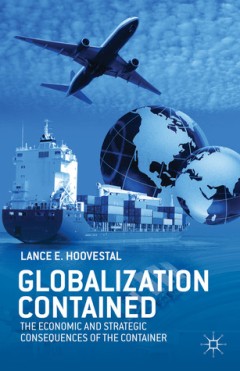
Globalization contained : the economic and strategic consequences of the cont…
Globalization contained : the economic and strategic consequences of the container
- Edisi
- -
- ISBN/ISSN
- 978-1-137-30442-1
- Deskripsi Fisik
- xiv, 225 p., 21 cm
- Judul Seri
- -
- No. Panggil
- TXT LO HOO g

Review Of Maritime Transport 2014
Global economic growth faltered in 2013 as economic activity in developing regions suffered setbacks and as the situation in the advanced economies improved only slightly. Prospects for the world economy, trade and shipping seem to be improving although a number of risks mostly on the downside remain.
- Edisi
- -
- ISBN/ISSN
- 978-92-1-112878-9
- Deskripsi Fisik
- xiii, 118 p., : illus: table : 30 cm
- Judul Seri
- -
- No. Panggil
- REF MR UNC r
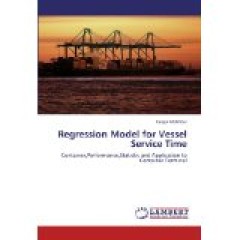
Regression Model for Vessel Service Time: Container,Performance,Statistic and…
The rapid development in container terminal ports in providing efficient and effective services and high port productivity are necessary nowadays. It is happen as current demands from new generation of container vessels are an indicator to the container terminal operators how serious international trade via sea. This work shares scenario of service time at container terminal as a sign of its pe…
- Edisi
- -
- ISBN/ISSN
- 9778-3-8473-4789-7
- Deskripsi Fisik
- 136p. ; 23cm.
- Judul Seri
- -
- No. Panggil
- TXT PO MOK r C.1

Sistim peti kemas = container system
Sistim peti kemas = container system
- Edisi
- -
- ISBN/ISSN
- 978-979-95560-2-8
- Deskripsi Fisik
- v, 109 p., 21 cm
- Judul Seri
- -
- No. Panggil
- 627.2 KOL s
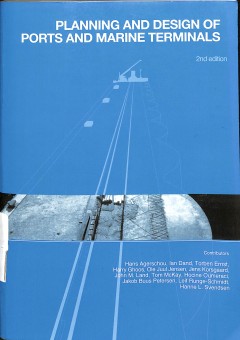
Planning And Design Of Ports And Marine Terminal
Following from the success of the first edition, written by a collection of eminent figures in the field, this new edition continues to look at the rational planning for port facilities requirements (berths, storage and cargo handling equipment), organisations, management and operations with relation to planning and design of ports and marine terminals.
- Edisi
- 2nd Edition
- ISBN/ISSN
- 978-07277-3498-3
- Deskripsi Fisik
- xviii, 446 p., ; illus : index ; 24 cm
- Judul Seri
- -
- No. Panggil
- LC 627.2 AGE p
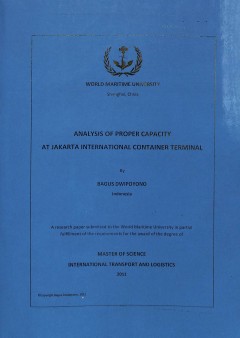
Analysis of proper capacity at Jakarta International Container Terminal
As a facility with high capital investment, container terminal tends to be operated with maximum capacity by using high utilization of facilities and equipment rather than a proper throughput. However, a high utilization is leading to the ships waiting time and as consequence lowering the service level. Therefore a study is needed to determine the proper capacity by considering the interest of …
- Edisi
- -
- ISBN/ISSN
- -
- Deskripsi Fisik
- xiii, 100 p., ; illus : 30 cm ; bibliography
- Judul Seri
- -
- No. Panggil
- TD PO DWI a C.1
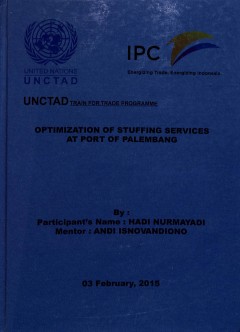
Optimization of stuffing services at port of Palembang
- Edisi
- -
- ISBN/ISSN
- -
- Deskripsi Fisik
- 30 p., ; 33 cm
- Judul Seri
- -
- No. Panggil
- TD PO NUR o
- Edisi
- -
- ISBN/ISSN
- -
- Deskripsi Fisik
- 30 p., ; 33 cm
- Judul Seri
- -
- No. Panggil
- TD PO NUR o
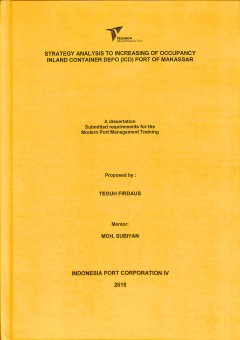
Strategy analysis to increasing of occupancy inland container depo (ICD) port…
Inland Container Depo (ICD) is one of the facilities owned by PT (Persero) Pelabuhan Indonesia IV of Makassar. The Average growth of containers through the Makassar. The average growth of containers through the Makassar Container Terminal 9%, but it is contrary to the ICD occupancy decreased from year to year due to there are some container depot outside the port as a competitor. So that the …
- Edisi
- -
- ISBN/ISSN
- -
- Deskripsi Fisik
- v, 70 p, 30 cm; tabel
- Judul Seri
- -
- No. Panggil
- TD PO FIR s

Multimodal transport : the practitioner's definitive guide / the Singapore lo…
The Practitioner's Definitive Guide: Multimodal Transport is specifically written for freight forwarding personnel and those joining the industry, and also serves as a useful guide to anyone who needs to arrange transport for shipments. It provides comprehensive information on current practices, along with real-life case studies to illustrate actual fie…
- Edisi
- 3rd Edition
- ISBN/ISSN
- 978-981-434-228-5
- Deskripsi Fisik
- 212 p., 23 cm
- Judul Seri
- Guide to International Logistics
- No. Panggil
- 388.04 WAN m
Container terminals and cargo systems : design, operations management, and lo…
This book presents new insights and successful solutions to the operational problems of automated container terminals and cargo systems. It comprises reports on the state of the art, applications of quantitative methods, as well as case studies and simulation results. Its contributions are written by leading experts from academia and business and address practitioners and researchers in logisti…
- Edisi
- -
- ISBN/ISSN
- 978-3-642-08049-4
- Deskripsi Fisik
- vi, 381 p., 21 cm
- Judul Seri
- -
- No. Panggil
- TXT PO KIM c
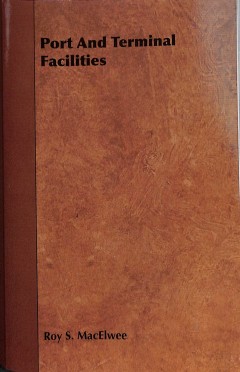
Port and terminal facilities
Many of the earliest books, particularly those dating back to the 1900s and before, are now extremely scarce and increasingly expensive. We are republishing these classic works in affordable, high quality, modern editions, using the original text and artwork.
- Edisi
- 2nd Ed.
- ISBN/ISSN
- 978-1-44461-998-0
- Deskripsi Fisik
- ix, 315 p., ; illus : 21 cm ; bibliography; index;
- Judul Seri
- -
- No. Panggil
- TXT PO MAC p
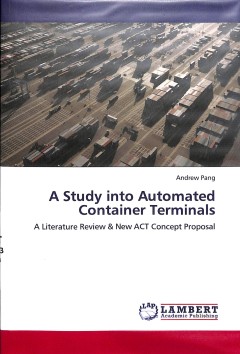
A Study into Automated Container Terminals: A Literature Review & New ACT Con…
Globalization has drastically increased the amount of trade between different nations and this has lead to an exponential growth in shipping activities around the world. As a result, many container terminals are struggling to cope with this new surge of containers moving through their yards. Numerous container terminals are looking at the possibility of automating their container terminal so as…
- Edisi
- -
- ISBN/ISSN
- 978-3-8443-8373-7
- Deskripsi Fisik
- 81p. ; 23cm.
- Judul Seri
- -
- No. Panggil
- TXT PO PAN a

Crane Scheduling in Container Terminals : Mathematical Models, Heuristics and…
The globalization of trade has lead to an enormous growth in sea transportation over the last years. A great majority of general cargo is containerized and handled in container terminals, which are essential hubs in sea transportation systems. The potential of cost saving in a container terminal is large and the workflow of a container terminal has to be very efficient. The focus of this book l…
- Edisi
- -
- ISBN/ISSN
- 978-3-639-04236-8
- Deskripsi Fisik
- 59p. ; 23cm.
- Judul Seri
- -
- No. Panggil
- TXT PO BOH c

Inaccuracy in traffic forecasts: lying or strategizing? A contextualist analy…
The purpose of this paper is to look into the fate of a troubled initiative in Hong Kong that was developed in the midst of discussions between Beijing and London leading towards the 1997 handover. It sets out to shred new light on the “forecasting gap”: the gap between the anticipated level of traffic and the real volume of traffic in the years following the opening of a new infrastructure
- Edisi
- Vol. 1 No. 1, 2009 pp. 7-22
- ISBN/ISSN
- 1757-4323
- Deskripsi Fisik
- 18 p.
- Judul Seri
- Asia-Pacific Journal of Business Administration
- No. Panggil
- ATC MR DUF i

Storage space allocation in container terminals
Container terminals are essential intermodal interfaces in the global transportation network. Efficient container handling at terminals is important in reducing transportation costs and keeping shipping schedules. In this paper, we study the storage space allocation problem in the storage yards of terminals. This problem is related to all the resources in terminal operations, including quay …
- Edisi
- 37 (2003) 883–903
- ISBN/ISSN
- -
- Deskripsi Fisik
- 21 p.
- Judul Seri
- Transportation Research
- No. Panggil
- ATC LO ZHA s

Technical Efficiency Analysis of Container Terminals in the Middle Eastern Re…
Despite an increasing number of studies on the efficiency of container terminals, their focus has mostly been on advanced and emerging markets. There are limited studies on container terminals in developing countries such as those of the Middle Eastern region, which are located in a critical geographic position in the international maritime route between the East and the West. Information on th…
- Edisi
- 31(4) (2015) 477-486
- ISBN/ISSN
- 2092-5212
- Deskripsi Fisik
- 10 p.
- Judul Seri
- The Asian Journal of Shipping and Logistics
- No. Panggil
- ATC LO ALM t

U.S. import/export container flow modeling and disruption analysis
International containerized freight movement is a vital part of the supply chain for many companies, anda critical element of moving consumer goods to points of retail sale within the U.S. Containerized imports also present a clear security concern (e.g., terrorists attempting to ship “dirty bombs,” chemical, biological or even nuclear weapons, into the U.S. in a shipping container). The go…
- Edisi
- 32 (2011) 3e14
- ISBN/ISSN
- 0739-8859
- Deskripsi Fisik
- 12 p.
- Judul Seri
- Research in Transportation Economics
- No. Panggil
- ATC LO JON u

Use of the Delphi method to determine the constraints that affect the future …
Who would have foreseen 40 years ago the launching of an 18 000 TEU container ship? The unprecedented growth of such ships presents an increasing challenge for port infrastructure planners. The paper concludes that during the next 20 years, the growth of container ships will depend on factors related to supply and demand, and to external factors. These factors will be defined as the constraints…
- Edisi
- Vol. 42, No. 3,
- ISBN/ISSN
- 263–277
- Deskripsi Fisik
- 16 p.
- Judul Seri
- Maritime Policy & Management
- No. Panggil
- ATC LO PAZ u

World container port throughput follows lognormal distribution
We show in this paper that the throughput data for the top 300 container ports reported each year by the various authorities follows a simple truncated lognormal distribution. This surprising phenomenon repeats itself every year from 1982 to 2006, despite many tumultuous changes in the container shipping world. The empirical data suggests that Gibrat’s Law of proportionate growth indeed holds…
- Edisi
- VOL. 37, NO. 4, 401–426
- ISBN/ISSN
- 1464–5254
- Deskripsi Fisik
- 28 p.
- Judul Seri
- Maritime Policy & Management: The flagship journal of international shipping and port research
- No. Panggil
- ATC LO DIN w

World container port rankings
Studying the traffic rankings of the world's busiest seaports and airports geographers are inclined to look for certain locational qualities or attributes that might help explain the rankings [I]. In this paper the 1995 ranking of the world's top 25 container load centres will be put in simple geographical context. No claim is made that this is the only useful context! It is obvious that the ph…
- Edisi
- VOL. 24, NO. 2, 175-181
- ISBN/ISSN
- -
- Deskripsi Fisik
- 9 p.
- Judul Seri
- Maritime Policy & Management: The flagship journal of international shipping and port research
- No. Panggil
- ATC LO FLE w

US container terminal leasing and pricing
Income from leasing container terminals and terminal facilities over the last 15 years has risen from miniscule levels to a point where it now represents a majority of the total income at some us ports [l]. This paper reviews the methods used to lease container terminals and terminal facilities, examines the leasing methodologies and pricing approaches used by us public port authorities, and di…
- Edisi
- VOL. 11, NO. 4, 277-288
- ISBN/ISSN
- -
- Deskripsi Fisik
- 13 p.
- Judul Seri
- Maritime Policy & Management: The flagship journal of international shipping and port research
- No. Panggil
- ATC LO DOW u

US container port resilience in a complex and dynamic world
The resilience of US container ports is increasingly challenged by disruptive and stressful events such as regulatory change, adverse weather, larger container ship sizes, changing patterns of trade and sea routes, and the still to be quantified effects of enlarging the capabilities and capacity of the Panama Canal. Port sustainability requires the port managers to be resilient in their practic…
- Edisi
- Vol. 43, No. 2, 179–191
- ISBN/ISSN
- 1464-5254
- Deskripsi Fisik
- 14 p.
- Judul Seri
- Maritime Policy & Management The flagship journal of international shipping and port research
- No. Panggil
- ATC LO JUS u

Urban road congestion, capacity expansion and port competition: empirical ana…
In this study, we empirically investigate the impacts of urban road congestion and road capacity expansion on the competition between major container ports in the US. We find that more delays on urban roads may cause shippers to switch to competing rival ports: a 1% increase in road congestion delays around the port is associated with a 0.90–2.48% decrease in the port’s container throughput…
- Edisi
- Vol. 40, No. 5, 417–438
- ISBN/ISSN
- -
- Deskripsi Fisik
- 24 p.
- Judul Seri
- Maritime Policy & Management: The flagship journal of international shipping and port research
- No. Panggil
- ATC LO WAN u

Unveiling co-operative networks and ‘hidden families’ in the container po…
Over the last few years, the progressive scarcity of land for greenfield projects in ports and the enormous financial resources required to realize new terminal facilities have induced international terminal operators (ITOs) to enter in various types of agreements. In particular, ITOs have growingly resorted to equity joint-ventures (EJVs) to develop new infrastructures and share project risks.…
- Edisi
- Vol. 41, No. 4, 384–404
- ISBN/ISSN
- -
- Deskripsi Fisik
- 23 p.
- Judul Seri
- Maritime Policy & Management: The flagship journal of international shipping and port research
- No. Panggil
- ATC LO PAR u

The size effect of a port on the container handling efficiency level and mark…
This study examines the relationship between the size of a port, its efficiency increase and the performance growth in the transshipment market. The hypothesis tested is that the bigger size of a port would increase the market share of the port in container transshipment; only when the size effect guarantees better ‘relative’ container handling efficiency in competing port system where the …
- Edisi
- VOL. 36, NO. 2, 117–129
- ISBN/ISSN
- 1464–5254
- Deskripsi Fisik
- 15 p.
- Judul Seri
- Maritime Policy & Management: The flagship journal of international shipping and port research
- No. Panggil
- ATC LO SOH t

The potential seasonal alternative of Asia–Europe container service via Nor…
The summer minimum extent of Arctic sea ice shrank drastically in these years, and the opportunity on Arctic international shipping emerged. The Northern Sea Route (NSR), formerly blocked by permanent ice, was completely ice-free in September in the past 3 years. Because this route is much shorter than conventional Asia–Europe shipping lane, many maritime countries have paid attention to expl…
- Edisi
- VOL. 38, NO. 5, 541–560
- ISBN/ISSN
- 1464–5254
- Deskripsi Fisik
- 20 p.
- Judul Seri
- The potential seasonal alternative of Asia–Europe
- No. Panggil
- ATC LO HUA t

The ownership and management structure of container terminal concessions
It is now over 25 years since the widespread concessioning of container terminals began. This article examines the impact of concessioning on the balance between public and private sector control, the use of competitive tendering to assign concessions, the structure of the Special Purpose Vehicles (SPVs) to which concessions were originally awarded, and the way in which the ownership of these S…
- Edisi
- VOL. 39, NO. 1, 7–26
- ISBN/ISSN
- 1464–5254
- Deskripsi Fisik
- 22 p.
- Judul Seri
- Maritime Policy & Management: The flagship journal of international shipping and port research
- No. Panggil
- ATC LO FAR t

The optimal ship sizes of container liner feeder services in Southeast Asia: …
Deploying containerships with increasing carrying capacities in achieving better capacity utilization has been well-documented. However, ship operators often face the problem in deploying containerships with the right size, especially given the capital-intensive nature of container liner shipping, which would lead to substantial implications if inappropriate ships were used. While studies on op…
- Edisi
- VOL. 35, NO. 4, 353–376
- ISBN/ISSN
- 1464–5254
- Deskripsi Fisik
- 26 p.
- Judul Seri
- Maritime Policy & Management: The flagship journal of international shipping and port research
- No. Panggil
- ATC LO KOI t

The hierarchical configuration of the container port industry: an application…
This paper aims to provide a hierarchical configuration of the container port industry. It attempts to do so by determining a port hierarchy and then, utilising this, deriving the nature of the spatial interactions between sample ports in East Asia. The former is determined by assessing the relative importance of a port within the given network, and the latter is mainly based on the significanc…
- Edisi
- VOL. 39, NO. 2, 169–187
- ISBN/ISSN
- 1464–5254
- Deskripsi Fisik
- 21 p.
- Judul Seri
- Maritime Policy & Management
- No. Panggil
- ATC LO CUL t

The growth potential of container shipping on the Yangtze River
Despite the rapid economic growth in the Yangtze River Delta area, the Yangtze River itself is lagging behind as measured by the ratio of container volume to total freight volume. According to the Ministry of Communications’ statistics, more than 70% of cargoes generated in the Yangtze Valley are suitable for containerized transport, but, at this time, only a fraction of these cargoes are act…
- Edisi
- VOL. 35, NO. 6, 535–549
- ISBN/ISSN
- 1464–5254
- Deskripsi Fisik
- 17 p.
- Judul Seri
- Maritime Policy & Management: The flagship journal of international shipping and port research
- No. Panggil
- ATC LO VEE t

The corporate geography of global container terminal operators
The terminal and stevedoring industry has expanded substantially in recent years with the emergence of global container terminal operators controlling large multinational portfolios of terminal assets. This paper deals with the emerging corporate geography in the container terminal industry with issues related to the similarities or differences among terminal locations, the processes leading to…
- Edisi
- VOL. 39, NO. 3, 249–279
- ISBN/ISSN
- 1464–5254
- Deskripsi Fisik
- 33 p.
- Judul Seri
- Maritime Policy & Management: The flagship journal of international shipping and port research
- No. Panggil
- ATC LO NOT t

The containerships of 1999
Ports are the next candidates for radical change. A jumbo containership can move boxes at sea for less than one cent per ton mile, and fast double-stack trains move them overland for less than three cents. A container can cross the Atlantic for $300, but the terminals consume $500 and too much time. The port of 1999 will work 24 hours and seven days a week. It will be manned by a few well-paid …
- Edisi
- VOL. 16, NO. 2, 133-145
- ISBN/ISSN
- 1464-5254
- Deskripsi Fisik
- 14 p.
- Judul Seri
- Maritime Policy & Management
- No. Panggil
- ATC LO EYR t

The container terminal community
Over the past 30 years, technological developments have not only aOEected the design and operation of the port function, but also the organizational and institutional relationships within the port community. Two inter-organizational interaction models are presented, drawing on the ® ndings of over 200 in-depth interviews with senior managers representing terminal operators, shipping lines, fee…
- Edisi
- 2001, VOL. 28, NO. 3, 279± 292
- ISBN/ISSN
- 1464± 5254
- Deskripsi Fisik
- 16 p.
- Judul Seri
- Maritime Policy & Management: The flagship journal of international shipping and port research
- No. Panggil
- ATC LO MAR t

The Caribbean basin: adjusting to global trends in containerization
Positioned strategically between major east–west and north–south trading routes, the Caribbean basin has become a locus of new service configurations in container shipping. Over the last decade global shipping lines have been restructuring their service networks in the region in order to integrate local services with the newly rationalized intercontinental connections. By comparing service …
- Edisi
- VOL. 32, NO. 3, 245–261
- ISBN/ISSN
- 1464–5254
- Deskripsi Fisik
- 19 p.
- Judul Seri
- Maritime Policy & Management: The flagship journal of international shipping and port research
- No. Panggil
- ATC LO MCC t

Tactical planning models for managing container flow and ship deployment
This paper addresses two practical problems from a liner shipping company, i.e. the container flow management problem and the ship deployment problem, at the tactical planning level. A sequential model and a joint optimisation model are formulated to solve the problems. Our results show that the company should implement the joint optimisation model at the tactical planning level to improve the …
- Edisi
- VOL. 38, NO. 5, 487–508
- ISBN/ISSN
- 1464–5254
- Deskripsi Fisik
- 23 p.
- Judul Seri
- Tactical planning models
- No. Panggil
- ATC LO LIU t

Stability and competition in intermodal container shipping: finding a balance
This article considers thc perennial topic of how to achieve an equilibrium balance between stability and competition in intermodal shipping. It argues that competition is becoming destructive, but that the imbalance is difficult to correct in a climate where competitive pressures are strong everywhere and restraints on competition are unfashionable. In this context, pricing of intermodal servi…
- Edisi
- 1998. VOL 25, NO 2, 129 147
- ISBN/ISSN
- -
- Deskripsi Fisik
- 21 p.
- Judul Seri
- Maritime Policy & Management: The flagship journal of international shipping and port research
- No. Panggil
- ATC LO GRA s

Socioeconomic factors affecting the job satisfaction levels of self-employed …
The job satisfaction level (JSL) of self-employed container truck drivers (SCTDs) is vital to the container trucking industry’s (CTI) stability in China. An anonymous field survey of 645 SCTDs was conducted at Shanghai Port. Three ordered probit models were, respectively, developed to analyze the drivers’ JSLs, their attitudes, and reactions to a CTI downturn. This study contributes to the …
- Edisi
- 2017
- ISBN/ISSN
- 1464-5254
- Deskripsi Fisik
- 17 p.
- Judul Seri
- Maritime Policy & Management The flagship journal of international shipping and port research
- No. Panggil
- ATC LO JIA s

Scheduling trucks in container terminals using a genetic algorithm
Trucks are the most popular transport equipment in most mega-terminals, and scheduling them to minimize makespan is a challenge that this article addresses and attempts to resolve. Specifically, the problem of scheduling a fleet of trucks to perform a set of transportation jobs with sequence dependent processing times and different ready times is investigated, and the use of a genetic algorithm…
- Edisi
- Vol. 39, No. 1, January 2007, 33–47
- ISBN/ISSN
- 1029-0273
- Deskripsi Fisik
- 16 p.
- Judul Seri
- Engineering Optimization
- No. Panggil
- ATC LO CNG s

Scheduling operations of a rail crane and container deliveries between rail a…
This article addresses the problem of scheduling container transfer operations in rail terminals. The overall problem can be divided into three smaller problems: constructing a dual-cycle delivery task by matching inbound and outbound containers; determining parking positions for trucks; and sequencing the delivery tasks for transfer by the rail crane. This article provides a mathematical model…
- Edisi
- Vol. 43, No. 6, June 2011, 597–613
- ISBN/ISSN
- 1029-0273
- Deskripsi Fisik
- 18 p.
- Judul Seri
- Engineering Optimization
- No. Panggil
- ATC LO JEO s

Scheduling material handling vehicles in a container terminal
Increasing global trade has created the need for efficient container ports. The goal of the port is to move containers as quickly as possible and at the least possible cost. Goods that are delayed at the port are inevitably tardy when delivered to the customer, and thus sanctioned by late charges. Two key activities in the port are (i) unloading of containers from truck and then storage in the …
- Edisi
- Vol. 14, No. 7, October–November 2003, 623–633
- ISBN/ISSN
- 1366–5871
- Deskripsi Fisik
- 12 p.
- Judul Seri
- Production Planning & Control: The Management of Operations
- No. Panggil
- ATC LO DAS s
 Karya Umum
Karya Umum  Filsafat
Filsafat  Agama
Agama  Ilmu-ilmu Sosial
Ilmu-ilmu Sosial  Bahasa
Bahasa  Ilmu-ilmu Murni
Ilmu-ilmu Murni  Ilmu-ilmu Terapan
Ilmu-ilmu Terapan  Kesenian, Hiburan, dan Olahraga
Kesenian, Hiburan, dan Olahraga  Kesusastraan
Kesusastraan  Geografi dan Sejarah
Geografi dan Sejarah